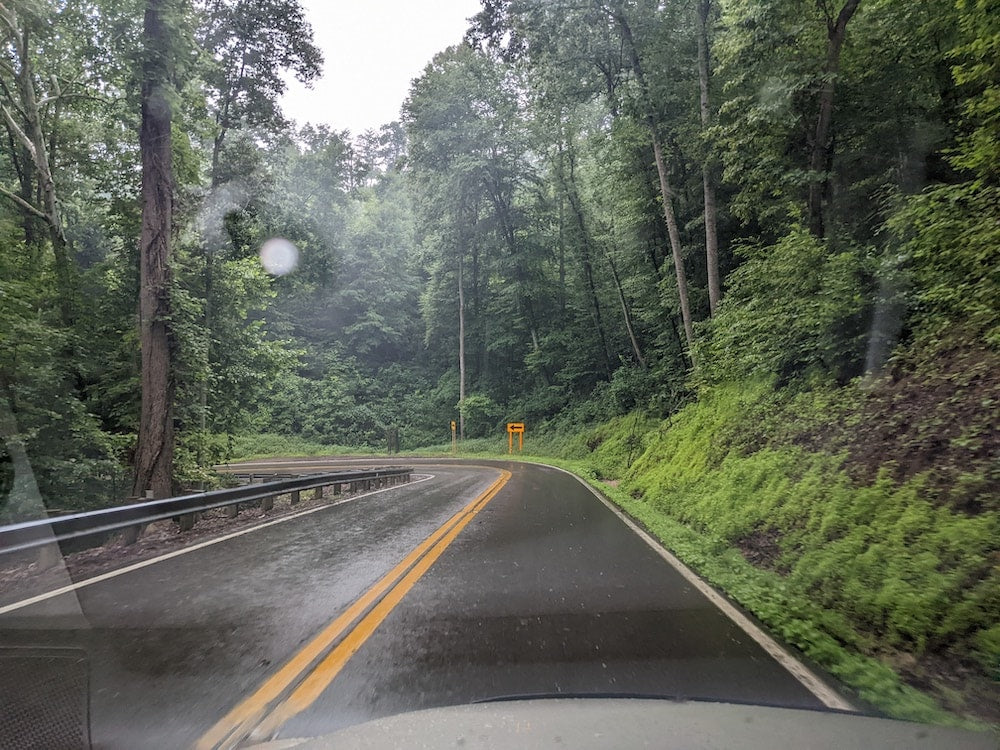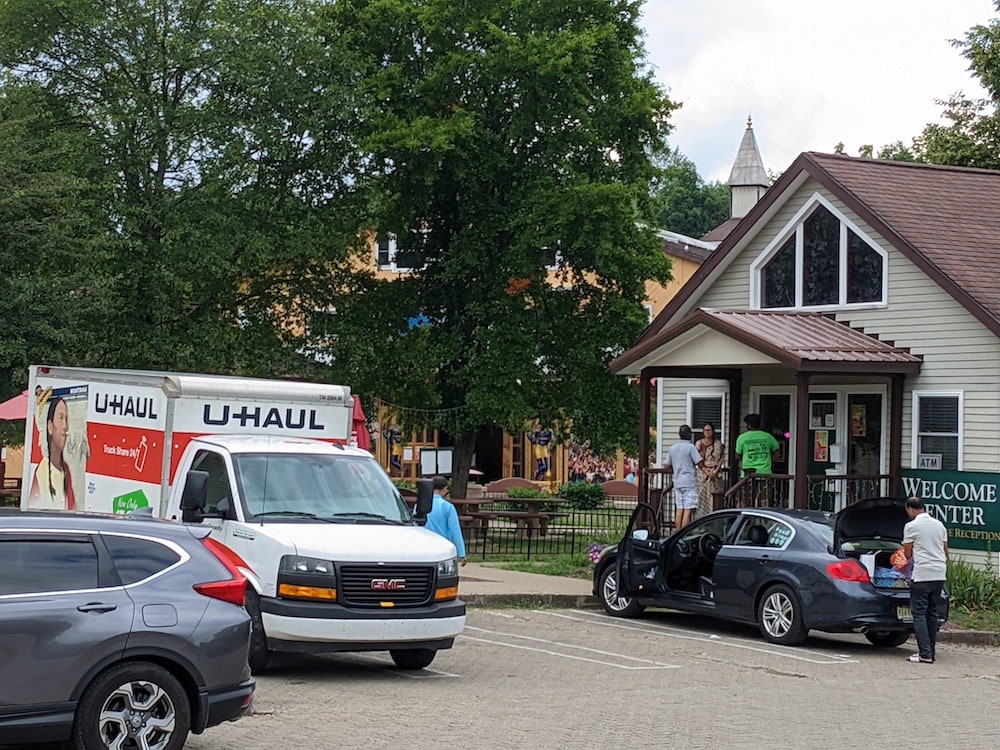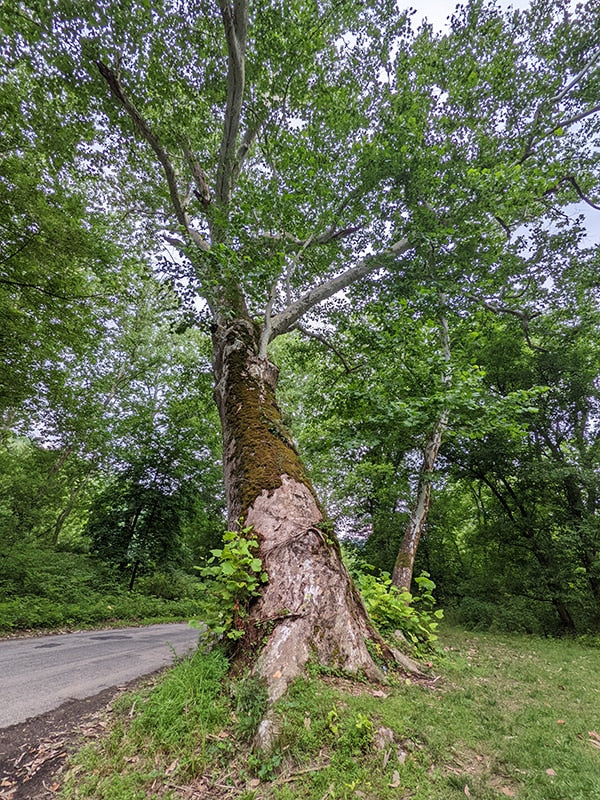Day Two: “Big Bucket, Big Bridges, Big Tree, Big Day”
A big day indeed, as we would travel through parts of three states today. As it turned out, the bulk of the day was spent traveling through Ohio. Our first checkpoint was to find “a very old log cabin hit by a massive tornado” in Xenia, Ohio. This was the Galloway Cabin, built in 1799 by James Galloway Sr. near the Little Miami River. Galloway was a hunter who provided game to the Army during the American Revolution. The cabin was moved in 1936, and then moved a second time in 1965 to its current location as the home of the Greene County Historical Society. A tornado in 1974 destroyed a lot of the town of Xenia, and damaged the cabin, which was restored.

The Galloway Cabin.
After finding the county courthouse in the town of Washington Court House, Ohio (yes, you read that correctly – it is the county seat of Fayette County), we had to find a house of another kind – the Octagon House, in Circleville, Ohio. This house was built nearby and moved to its present location, where it is awaiting a restoration. Presumably, the octagon shape was deemed “healthier” by its designer Orson Squire Fowler. The house was built by George W. Gregg in 1856, and was then sold with the attached farmland to the Crites family in 1920, who visited the house but never lived there. Tenant farmers lived in the house until 1998, and it was scheduled to be demolished in 2000 to make way for a Super Walmart store. As part of the deal, the Conservancy which owns the house was deeded the building and two acres of land at the back of the farm, and it took four months to roll the house half a mile across the field to its present location.
Unfortunately, due to the “No Trespassing” signage, we could not enter the property to get a better picture.

Octagon House.
Once departing Circleville, the rally entered an hours-long stretch through the Hocking Hills in southeast Ohio on various state and county roads. On top of the twisting and turning roads, it had started raining, so much of the day looked like this:

Driving through the Hocking Hills.
After checking in at the John Glenn Astronomy Park, and locating Woltz Road as another checkpoint, we had to find the Nelsonville Brick Plant in Nelsonville, Ohio. Established in 1877, the brick plant was producing as many as 25 million bricks per year by the mid 1880s. The bricks were used as pavers as well as for constructing buildings, and were sold under brand names such as Nelsonville Block, Hallwood Block, and Hocking Block, and examples of these can still be found around the country. With the eventual rise in usage of concrete and asphalt, demand tapered off and the company closed up permanently.
Some of the brick kilns were thankfully spared from demolition and are now part of the historic Nelsonville Brick Park.

A brick kiln at Nelsonville Brick Park.
Our next checkpoint was to find the Big Muskie Bucket near McConnellsville, Ohio. Being from a state where fishing is a major tourism draw, I had mental images of something to do with a fish. Instead, the Muskie Bucket is a 220 cubic yard, 240-ton bucket used in the largest coal mining dragline ever built, assembled over the course of more than two years on site at the Muskingum Mine. The bucket was dragged along the ground to strip away soil and rocks to get at the high-sulfur coal beneath. It operated between 1969 and 1991 until it became too expensive to operate and demand for the coal had declined. The entire dragline was disassembled and recycled, but the bucket remained on site and is part of the Miner’s Memorial Park inside Jesse Owens State Park.

The Big Muskie Bucket.
Our “Find It” clue of the day instructed us to find one of the historical markers for a naval wreck in the area. Navy ships can’t make their way this far inland, obviously, but the clue also mentioned it was also the site of the “first ZR-1 crash,” which probably grabbed the attention of Corvette enthusiasts. The ZR-1 was a zeppelin, the USS Shenandoah, which encountered turbulence during a storm, broke into three parts, and crashed in various places in the area.
After locating the historic Monroe Theater in Woodsville, Ohio, we had to drive to the Great Stone Viaduct in Bellaire, our final stop in Ohio. Driving through town, it is hard to miss, as it crosses the Ohio River and winds through town. The viaduct, built in 1871, was originally comprised of 43 stone arches. The CSX railroad abandoned a 20-arch section which was later purchased for preservation, development and education. Parts of the viaduct still remain in use today. The steel trestle bridge crosses the Ohio River, leading to the arched viaduct through town.

Great Stone Viaduct.
From Bellaire, the rally’s course took us over a bridge into Wheeling, West Virginia, where we had to locate the temporarily-closed Wheeling Suspension Bridge (originally constructed in the mid 1800s). Following that, we embarked on a route that would send us through the most rural of mountain roads in West Virginia, barely two cars wide and poorly patched over the decades. The beaten, narrow roads and dark canopy of trees led us to our next checkpoint – a Hare Krishna temple!
New Vrindaban is the location of this temple, which features Prabhupada’s Palace of Gold. Unfortunately, given all the activity in the area during that time of day, and our strict instructions to respect the property and privacy of others, I was not able to get in closer to see these buildings, beyond a glimpse of the temple through the trees. The history of the property is very interesting and worth reading about.

Near Prabhupada’s Palace of Gold.
Our time on these dicey West Virginia roads was not over, however. The route took us back down to another country road, and it turns onto a handful of others, where we had to locate the Biggest Tree in West Virginia. Apparently it is not the biggest tree, but in 1963, the Forestry division held a Big Tree Contest, and of all the nominations received, this particular tree, a sycamore estimated to be about 400 years old, scored the highest. It has a 311-inch circumference and stands about 117 feet tall.

The Biggest Tree in West Virginia.
Since our route took us through that tiny section of West Virginia pinched between Ohio and Pennsylvania, our final checkpoint of the day was to locate one of the many covered bridges in Washington County, Pennsylvania. The closest I could find on the route, and the closest to an Interstate highway, was the Brownlee Covered Bridge.

The Brownlee Covered Bridge.
Our stop for the night was in Pittsburgh, with an optional post-rally meet-up at Klavon’s Ice Cream Parlor downtown. As not many had arrived, I left after a few minutes to make my way up to the hotel, about 20 minutes north of the city. I looked forward to another evening of plotting the next day’s stops and getting some much-needed rest.
The final part of the Rust Belt Ramble series takes us from the birthplace of the Jeep up to a relocated piece of Detroit history, which was not in the rally booklet.
Header image: some of the more colorful rally participants. All images courtesy of the author.













0 comments